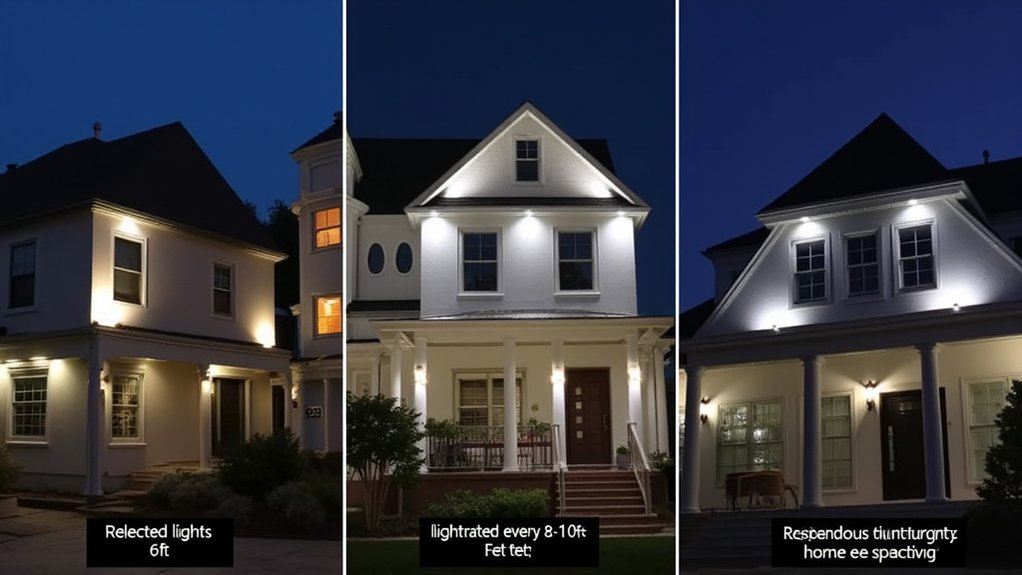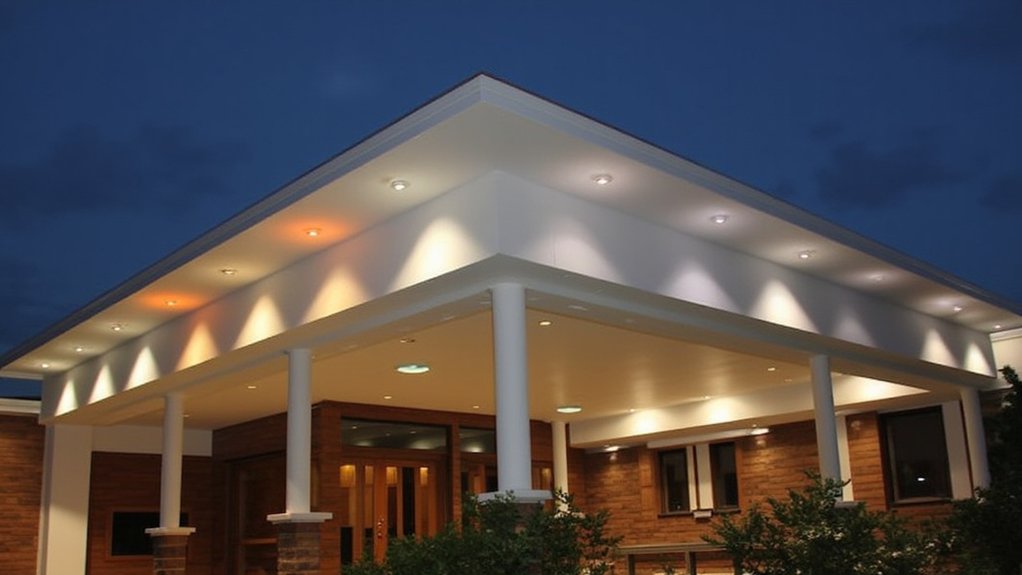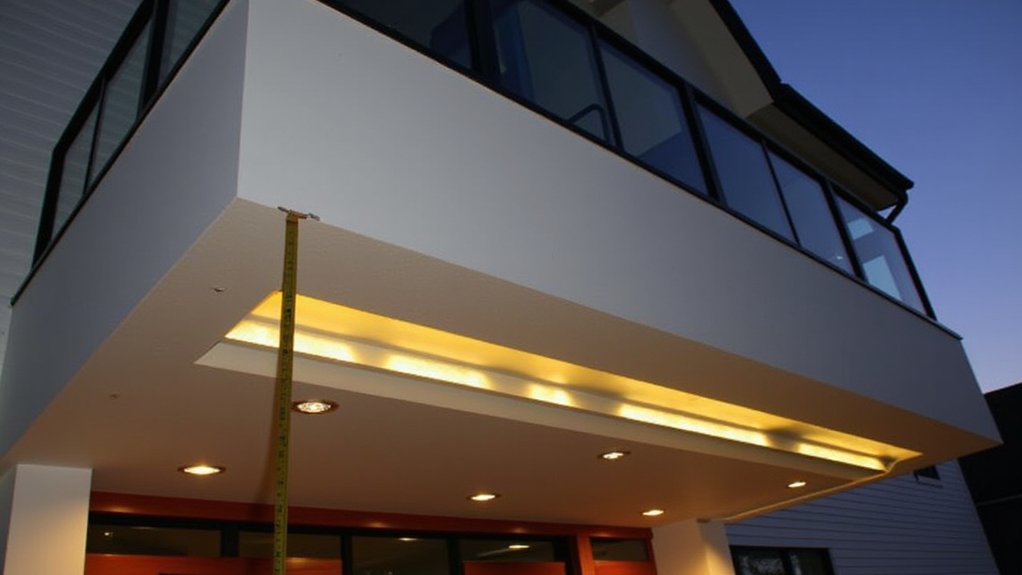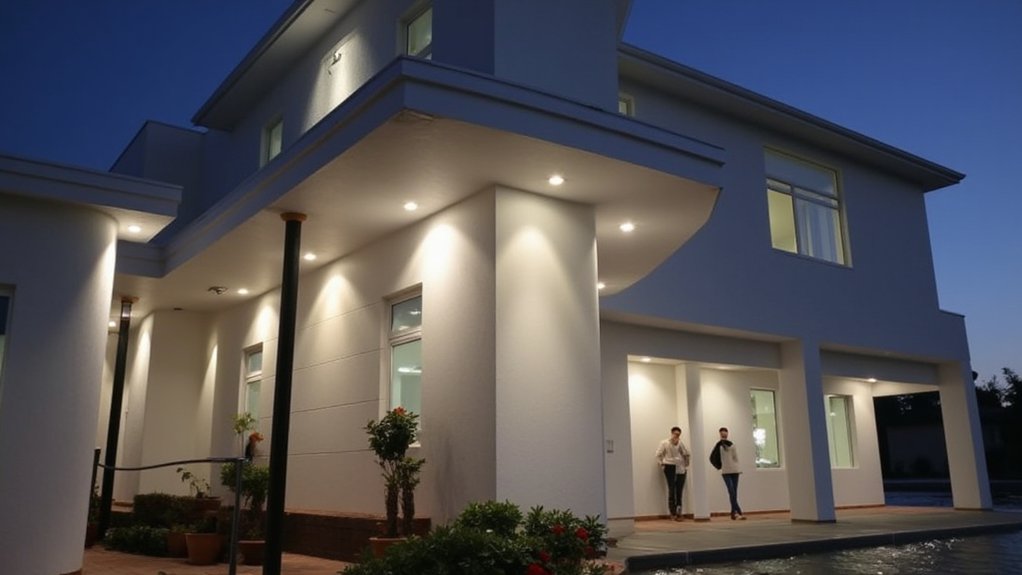Your soffit lights can make or break your home’s nighttime curb appeal. Professional lighting designer Sarah Chen notes, “The secret to stunning exterior lighting lies in proper spacing – it’s both art and science.” While general guidelines suggest 6-foot intervals, your home’s architectural style actually determines the ideal distance between fixtures. Understanding the proper spacing for your specific situation will help you create that perfect balance of illumination and aesthetic appeal.
Standard Spacing Guidelines for Different Home Styles

Three primary spacing guidelines help determine ideal soffit light placement based on your home’s architectural style.
For modern home styles, you’ll want to space lights 4-6 feet apart to create clean, even illumination along straight lines. “Contemporary designs benefit from consistent, rhythmic spacing,” notes lighting architect Sarah Chen.
Traditional design homes typically look best with lights placed 6-8 feet apart, allowing for softer, more gradual shifts between lit areas. Position fixtures near architectural features like columns or dormers.
For Mediterranean or craftsman-style homes, space lights 5-7 feet apart, adjusting placement to highlight decorative eaves and detailed trim work. Remember to take into account your roof’s pitch – steeper angles may require closer spacing to maintain consistent ground illumination.
Factors That Determine Optimal Light Placement

While many homeowners focus primarily on fixture styles, several key factors work together to determine the ideal placement of soffit lights. “The success of exterior lighting depends on understanding your home’s unique characteristics,” explains lighting designer Mark Thompson.
Key placement factors include:
- Architectural features (columns, windows, doorways)
- House height and soffit depth
- Light intensity needs for different areas
- Fixture types and beam spread angles
- Landscaping elements that affect light distribution
- Local building codes and regulations
“You’ll want to adjust spacing based on your light fixture’s beam angle and intensity,” notes Thompson. “A narrow-beam downlight typically needs closer spacing than a wide-angle flood light.” Consider your home’s specific needs when planning placement, as proper spacing guarantees even illumination without creating harsh spotlighting or dark zones.
Calculating the Right Distance Between Fixtures

To determine the ideal spacing between soffit lights, you’ll need to calculate the effective beam spread at ground level. “I recommend starting with a basic formula – multiply your soffit height by the tangent of your fixture’s beam angle,” says electrical contractor Jim Davis.
For standard 8-foot soffits, space your lights 4-6 feet apart, adjusting based on fixture brightness and light color. Follow these guidelines:
- Bright white lights (3000+ lumens): Space 6 feet apart
- Medium brightness (2000-3000 lumens): Space 5 feet apart
- Softer lights (1000-2000 lumens): Space 4 feet apart
For uniform illumination, measure and mark your spacing points before installation. “Always test one section first to confirm your calculations deliver the desired lighting effect,” advises Davis.
Common Spacing Mistakes to Avoid
Despite careful planning, homeowners often make several costly mistakes when spacing their soffit lights. “The most common error I see is clustering lights too closely near entryways while leaving dark spots elsewhere,” notes lighting designer Sarah Chen.
Watch out for these spacing errors that can ruin your light distribution:
- Installing fixtures directly above windows, which creates harsh reflections
- Placing lights too far apart (over 8 feet), resulting in shadowy gaps
- Failing to account for architectural features like corners and columns
- Positioning lights without considering landscaping shadows
To avoid uneven illumination, you’ll want to map out your entire soffit layout before installation. “Think of light coverage as overlapping circles, not isolated spots,” Chen advises. “Each fixture should complement its neighbors for seamless illumination.”
Installing Soffit Lights in Special Areas and Corners
Special areas and corners require extra attention when installing soffit lights to confirm proper illumination throughout these challenging spaces. “Corners often get overlooked, but they’re actually prime spots for creating depth and preventing dark zones,” explains lighting expert Mike Rodriguez.
For corner installations, you’ll want to position lights 12-18 inches from each wall intersection. When working with special lighting areas like entryways or architectural features, follow these guidelines:
- Place fixtures 24 inches from doorframes
- Install additional lights over columns or posts
- Add double fixtures at major corners
- Space lights closer together (every 4-6 feet) around curved soffits
- Position lights 18 inches from exterior wall corners
Remember to test your layout at night before permanent installation to confirm even coverage and proper illumination of all special features.
Frequently Asked Questions
What Color Temperature Is Best for Outdoor Soffit Lighting?
You’ll achieve the best outdoor ambiance with 2700K-3000K warm white for a cozy feel, while 4000K cool white offers better lighting efficiency. Choose based on your home’s style and purpose.
How Long Do LED Soffit Lights Typically Last Before Needing Replacement?
You’ll be amazed how your LED soffit lights can shine bright for 25,000 to 50,000 hours – that’s about 15-20 years of regular evening use before needing replacement in typical conditions.
Can Soffit Lights Be Installed if There Are Existing Gutter Guards?
You can install soffit lights with gutter guards in place, but you’ll need to ascertain proper clearance and access. Some gutter guard styles may require temporary removal during soffit light installation.
Do Soffit Lights Attract Insects More Than Other Outdoor Lighting Options?
You’ll notice soffit lights can attract insects similar to other outdoor lighting. To reduce insect attraction, consider using warm-colored LED bulbs or alternative lighting options like path lights and ground-mounted fixtures.
Are Motion Sensors Compatible With Most Types of Soffit Lights?
You’ll find most soffit lights are compatible with motion sensors, whether you’re using recessed cans, LED downlights, or traditional fixtures. Just make certain your motion sensor matches the light’s voltage requirements.


